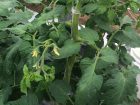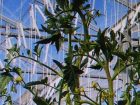
Features
Crop Culture
Inputs
Understanding the Signals of Tomato Plants
Study their language, interpret it properly and make decisions that are most beneficial to the crop.
June 8, 2016 By Dr. Mohyuddin Mirza
A grower recently sent me a pair of photos (1 and 2) of tomato plants.
Most of the plants in perimeter rows (Photo 1) had leaves coming out of their flower clusters. Then I found Photo 2, which had other clues as to what the problem was.
So then, what is this tomato plant trying to tell us?
- Leaves are coming out of flower cluster at a young age.
- Plant appears to be very healthy.
- The colour is good and dark green.
- The plants showing these symptoms are located in the perimeter rows, especially on the north side.
- Fruiting clusters can also show a leaf coming out from the end of the cluster (Photo 2).
The grower gave me the following information:
- Average night temperature was 18 C.
- Average day temperature was set at 22 C.
- The 24-hour average temperature was around 18.5 C.
- The temperature at the base of the coir bags was 10-12 C.
- The stems were distinctly purple in those plants showing symptoms.
There was enough information to conclude the plant was confused by the temperature signals it was getting.
The confusion was that the plant had entered into a flowering mode that is generative, but the air temperature was sending a signal to give more leafy or vegetative growth.
The reason why the symptoms were more prevalent in the plants on the perimeter of the greenhouse was a lack of heating pipes, and thus the air temperature was lower than the set-point.
My experience is that such symptoms indicate a night temperature of around 14 C for a few hours.
Once we understood this signal, we were able to turn the plant around by raising the 24-hour average temperature. There are many ways to do this. You can raise the night temperature or you can raise the day temperature by adjusting the venting set-point, along with many other set-point strategies.
I would like to point out that the fruit produced on such clusters will show what are called “cat-faced” features. The blossom end of the fruit is split as shown in Photo 3.
Such fruit is not marketable and is a drain on a plant’s energy balance. Growers may decide to remove the entire cluster if it shows the symptoms of leaves coming out of cluster, or they could remove the fruit as early as possible.
WATCH FOR SYMPTOMS OF BLOTCHY RIPENING FRUIT
Fruit has many disorders, however, I am seeing more of what is called “blotchy ripening.”
Photo 4 shows a cluster tomato where two fruits are showing the symptoms. Photo 5 is of a Roma variety.
We usually have much better nutrition management practices but once in a while such uneven ripening occurs. It is caused by a temporary shortage of potassium. I am calling it “temporary” because when fruit load is heavy, some fruits may not get enough potassium.
I see potassium levels very low in leach as well. Potassium is a mobile element and is moved from lower leaves to upper leaves. Always check to see if any lower leaves are showing a potassium deficiency.
Photo 6 shows early deficiency of potassium. If the problem is not diagnosed and additional levels of potassium are not supplied, the symptoms get worse and a blotchy ripening of fruit takes place.
SOME VERY GENERATIVE SIGNALS OF TOMATO CROPS
Tomato is grown as one long crop. During spring and summer, plants become very generative:
- Tops become very thin and spindly.
- The leaf colour becomes significantly bluish.
- The clusters are weak.
- The flower colour is yellow-orange.
- Less pollen is produced and pollen viability is reduced. With crops grown in hot climates where the temperature is consistently over 30 C, you generally find there is no pollination and consequently no fruit.
- The fruit doesn’t size up and it gets soft, as if reverse loss of water has occurred.
WORKING WITH A GENERATIVE TOMATO PLANT
Photo 7 is an example of a generative tomato plant. What can be done to correct this?
- Provide shade to the crop to help bring the temperature down.
- Adjust the 24-hour average temperature wherever possible.
- Bring the EC of the feed and leach down, preferably below 2.8 mS/cm.
- If a cluster is of very poor quality, remove it.
- Lower the plants early. The temperature is greater as you go higher in the greenhouse.
- Use fogging systems or evaporative coolers wherever possible.
This is not the complete story of tomato signals.
But I just want to emphasize that if you hope to consistently produce over 70 kg/m2 then you must pay close attention to your plants.
Understand their language, interpret it properly and make decisions that are most beneficial to your plants.
Dr. Mohyuddin Mirza is an industry consultant. He can be contacted at drmirzaconsultants@gmail.com.
Print this page






